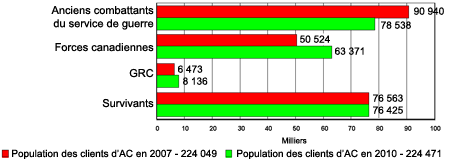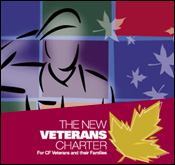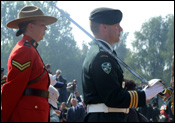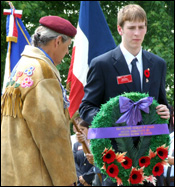Common menu bar links
Breadcrumb Trail
ARCHIVED - RPP 2007-2008
Veterans Affairs
 This page has been archived.
This page has been archived.
Archived Content
Information identified as archived on the Web is for reference, research or recordkeeping purposes. It has not been altered or updated after the date of archiving. Web pages that are archived on the Web are not subject to the Government of Canada Web Standards. As per the Communications Policy of the Government of Canada, you can request alternate formats on the "Contact Us" page.
Section I – Overview
Minister's Message

As Canadians, we owe tremendous gratitude to those men and women who have courageously served our country in times of war, peacekeeping and military operations. Our war service Veterans helped forge our nation's identity on the battlefields of the 20th century while Canadian Forces members and Veterans, and members of the Royal Canadian Mounted Police (RCMP) continue their contribution to the Canada we know today. In return, we are committed to care for them in their time of need and to remember and honour their sacrifices and achievements.
As Minister of Veterans Affairs Canada, it is with great pride that I present our 2007-2008 Report on Plans and Priorities. This report outlines where Veterans Affairs will focus its energies over the next three fiscal years by: creating a Veterans' Bill of Rights; developing options for an Ombudsman; developing options to resolve the concerns raised about the health effects of Agent Orange or other unregistered US military herbicide use at Canadian Forces Base Gagetown; delivering our modernized suite of programs and services; implementing a mental health strategy; responding to the changing health care needs of our older war service Veterans; and, increasing Canadians' participation, especially our youth, in remembrance activities.
Canada's involvement in worldwide operations has grown over the years, putting more and more Canadian Forces members in difficult, unpredictable and dangerous surroundings. As a result, the number of our Canadian Forces clients has doubled in the past five years and is expected to continue to rise for the foreseeable future. Our service men and women now releasing from the Canadian Forces have very different needs than our older, war service Veterans. That's why the New Veterans Charter was designed to provide post-war Canadian Forces members, Veterans and their families with the means to make a successful transition to civilian life.
As part of our commitment to our older war service Veterans, we have embarked on a health services review that will identify options for future improvements to our programs and services to give Veterans and their families more care options, all on the basis of need.
It is more important than ever that all Canadians, especially youth, keep the legacy of our war service Veterans alive. We will continue to work with organizations across the country to provide Canadians with more opportunities to participate in remembrance activities in their communities. We will also continue to ensure the preservation, care and dignity of Canada's cenotaphs and monuments which honour our Veterans, war dead, and significant military events. In particular, we will dedicate the restored Canadian National Vimy Memorial in April 2007 and provide opportunities for Canadians to take part in remembrance activities across Canada and in Europe.
I am proud of Veterans Affairs Canada's dedicated staff and their commitment to serving and honouring our clients. I invite all Canadians and Parliamentarians to read our report and to use the Web links found at the end to learn more about the work done on your behalf for our Veterans, members of the Canadian Forces and the RCMP.

The Honourable Greg Thompson, P.C., M.P.
Minister of Veterans Affairs
Chair's Message

The Veterans Review and Appeal Board has the unique responsibility of providing a disability compensation redress program for Canada's Veterans, members of the Canadian Forces and RCMP, and their families. I am pleased to present this report of the Board's plans and priorities for 2007-2008.
The Board is committed to providing a fair and effective appeal program. In the National Applicant Satisfaction Survey 2005, the majority of respondents told us that they were positive about their experience with the hearing process. They also identified areas for improvement such as timeliness and the need for more staff and Members with military and medical backgrounds and knowledge. Their concerns are addressed in our Strategic Plan 2006-2009.
During the 2007-2010 planning period, the Board will continue to look for opportunities to make improvements in program delivery and to enhance communication with appellants and stakeholders. I am confident that the Board will successfully meet its commitments to demonstrate fairness, competence and excellence in service to Canadians.

Victor A. Marchand
Chair, Veterans Review and Appeal Board
Management Representation Statement
We submit, for tabling in Parliament, the 2007-2008 Report on Plans and Priorities for Veterans Affairs, a Portfolio comprising Veterans Affairs Canada (VAC) and the Veterans Review and Appeal Board (VRAB).
This document has been prepared based on the reporting principles contained in the Guide for the Preparation of Part III of the 2007-2008 Estimates: Reports on Plans and Priorities and Departmental Performance Reports:
- It adheres to the specific reporting requirements outlined in the Treasury Board Secretariat guidance;
- It is based on the Portfolio's Strategic Outcomes and Program Activity Architecture that were approved by the Treasury Board;
- It presents consistent, comprehensive, balanced and reliable information;
- It provides a basis of accountability for the results achieved with the resources and authorities entrusted to it; and
- It reports finances based on approved planned spending numbers from the Treasury Board Secretariat in the RPP.

Suzanne Tining
Deputy Minister
Veterans Affairs Canada
February 6, 2007

Victor A. Marchand
Chair
Veterans Review and Appeal Board
February 6, 2007
Summary Information
Veterans Affairs exists to serve and pay tribute to the brave men and women of Canada who have unselfishly contributed to global peace and security in times of war and in a variety of peacekeeping, peace enforcement, and humanitarian operations around the world. Veterans Affairs is a portfolio consisting of two distinct and separate organizations: Veterans Affairs Canada (the Department) and the Veterans Review and Appeal Board (the Board) which operates at arm's length from the Department. In order to fulfill these responsibilities, it is estimated that the following financial and human resources will be required over the next three fiscal years:
Planned Spending and Human Resources for Veterans Affairs
Financial Resources ($ millions)
| 2007-2008 | 2008-2009 | 2009-2010 | |
| Veterans Affairs Canada | 3,364.2 | 3,379.0 | 3,356.8 |
| Veterans Review and Appeal Board | 13.7 | 13.6 | 13.6 |
Human Resources (full time equivalents)
| 2007-2008 | 2008-2009 | 2009-2010 | |
| Veterans Affairs Canada | 3,553 | 3,538 | 3,538 |
| Veterans Review and Appeal Board | 143 | 143 | 143 |
Portfolio Priorities
| Name | Type | |
| 1 | Enhancing and adapting programs and services to meet the needs of our Veterans, serving members, other clients and their families (VAC) | Ongoing |
| 2 | Implementing a Mental Health Strategy to enhance capacity to meet the mental health needs of clients (VAC) | Ongoing |
| 3 | Engaging Canadians in community-based remembrance activities with an emphasis on Canada's youth (VAC) | Ongoing |
| 4 | Enhancing organizational effectiveness (VAC) | Ongoing |
| 5 | Improved program delivery (VRAB) | Ongoing |
| 6 | Engaged communication with appellants and stakeholders (VRAB) | Ongoing |
Portfolio Plans and Priorities
Veterans Affairs has three strategic outcomes (two for Veterans Affairs Canada and one for Veterans Review and Appeal Board) with a total of six priorities. The following two tables illustrate how these strategic outcomes, program activities and priorities are aligned, and how the planned spending is allocated.
Portfolio Priorities by Strategic Outcome – Veterans Affairs Canada
| Planned Spending ($ millions) | |||||
| Expected Results | 2007-2008 | 2008-2009 | 2009-2010 | Contributes to the following priority | |
| Strategic Outcome #1: Eligible Veterans and other clients achieve their optimum level of well-being through programs and services that support their care, treatment, independence, and re-establishment. | |||||
| Program Activity | |||||
| Pensions, Awards, and Allowances for Disability and Death; and Financial Support | Eligible Veterans and others are appropriately compensated to contribute to their well-being | 2,182.6 | 2,193.8 | 2,175.3 | Priorities 1, 2 and 4 |
| Health Care and Re-establishment Benefits and Services | Eligible Veterans and others receive appropriate health benefits and rehabilitation services to contribute to their well-being | 1,128.7 | 1,134.7 | 1,131.0 | Priorities 1, 2 and 4 |
| Strategic Outcome #2: Canadians remember and demonstrate their recognition of all those who served in Canada's efforts during war, military conflict and peace. | |||||
| Program Activity | |||||
| Remembrance Programming | Canadians who commemorate, understand and value the achievements and sacrifices of those who have served Canada in war, military conflict and peace | 52.9 | 50.5 | 50.5 | Priorities 3 and 4 |
Portfolio Priorities by Strategic Outcome – Veterans Review and Appeal Board
| Planned Spending ($ millions) | |||||
| Expected Results | 2007-2008 | 2008-2009 | 2009-2010 | Contributes to the following priority | |
| Strategic Outcome #3: Fair and effective resolution of disability pension, disability award, and War Veterans Allowance appeals from Canada's war Veterans, eligible Canadian Forces Veterans and members, RCMP clients, qualified civilians and their families. | |||||
| Program Activity | |||||
| Veterans Review and Appeal Board redress process for disability pensions and awards | Fairness in the Disability Pension, Disability Award and War Veterans Allowance Program | 13.7 | 13.6 | 13.6 | Priorities 5 and 6 |
Operating Environment
Veterans Affairs delivers its programs and services within an environment that is influenced by many internal and external factors such as the Government's broader policy priorities, the Federal Accountability Act, the changing demographics of the Canadian workforce, the changing demographics, expectations and program needs of our clients, and Canada's involvement in international operations.
The Government of Canada's policy agenda is built around the following: presentation of a budget that controls spending, lowers taxes and offers the provinces a fair deal to restore fiscal and jurisdictional balance in Canada; continued efforts to make our streets and communities safer; making Canada's institutions more democratic and more accountable; standing up for Canada's interests and values on the world stage; and, more action to protect the environment and the health of Canadians.
The Government of Canada emphasizes results and values-based management, as well as responsible spending and due diligence in a government that is open, transparent and accountable. The current emphasis of public service renewal is to attract and retain top-quality employees, emphasizing excellence, leadership and teamwork while making human resources management more flexible and responsive to employees' needs. In addition, the Canadian workforce is becoming increasingly diverse and consideration must be given to the representation of visible minorities, Aboriginal peoples and women. The Portfolio's implementation of the Public Service Modernization Act (PSMA) - which came into force on December 31, 2005 - is dependant on our ability to integrate human resource planning and business planning.
Building on the requirement of the Federal Accountability Act for the evaluation of all grant and contribution programs, the Government of Canada is strengthening the Expenditure Management System to support:
- managing for results by establishing clear responsibilities for departments to better define the expected outcomes of new and existing programs;
- decision-making for results by ensuring that all new programs are fully and effectively integrated with existing programs by reviewing all spending to ensure efficiency, effectiveness and ongoing value for money; and
- reporting for results by improving the quality of departmental and Government-wide reporting to Parliament.
For its part, while delivering changing services to its clients and continuing to review all spending, Veterans Affairs will integrate financial and non-financial information to demonstrate to Canadians that the Portfolio is delivering value for money.

VAC's workload is expected to increase and place a strain on delivery capabilities as staff work with new clients on a more intensive case-by-case basis. The changing demographics, expectations and program needs of our clients must also be considered, as well as the delivery of Health Care benefits and services and improving access to those existing programs and services that are designed to meet the particular needs of our clients. The average age of First World War Veterans is 106, the average age of Second World War Veterans is 83, and the average age of Korean War Veterans is 74, while the average age of releasing Canadian Forces members is 36. For this reason, Veterans Affairs requires a robust forecasting model in order to identify trends so that Portfolio resources can be properly allocated.

The number of Canadian Forces (CF) members serving in peacekeeping missions, peacemaking missions and other international operations has increased significantly in recent years, with frequent and prolonged deployments to zones of conflict and unrest. The result of this increased danger, pace and intensity in operations for our armed forces is a corresponding need for care and treatment from VAC for physical and mental health conditions resulting from their service. The New Veterans Charter is a response to this need and also supports the Government's commitment to increasing enlistment and retaining members in the Canadian Forces.

The members of the RCMP also live and work in a unique culture and face new challenges both at home and abroad. VAC recognizes the need to collaborate with the RCMP to ensure that VAC's programs and services respond to the needs of our RCMP clients.
VAC has also developed partnerships with other government departments and agencies (e.g. Department of National Defence, Canadian Heritage), other levels of government, other countries, Veterans' associations, and service providers. These partnerships play a significant role in the delivery of our benefits, services and remembrance programming.
As part of a government-wide development of influenza pandemic contingency plans, Veterans Affairs is developing a plan to ensure the continual delivery of programs and services to clients in the event of a possible influenza pandemic.
A significant element of the Portfolio's planning is the changing composition of our client groups. Over the planning period, the number of clients is forecasted to increase slightly from 224,049 in 2007 to 226,471 in 2010. The following chart illustrates the breakdown of VAC's client groups by number of clients of each group in 2007 and 2010.
Forecasted VAC Client Population
| 2007 | 2010 | |
| War Service Veterans | 90,490 | 78,538 |
| Canadian Forces | 50,524 | 63,371 |
| RCMP | 6,473 | 8,136 |
| Survivors | 76,563 | 76,425 |
| Total | 224,049 | 226,471 |
Graph Version

Priorities – Veterans Affairs Canada
The over-arching goal of VAC's Strategic Plan is Improving Program and Service Delivery and focusses primarily on two strategic outcomes.
First, VAC will continue to provide exemplary client-centred service, supporting the health and wellness of our clients as we strive to meet their needs. The programs offered through the New Veterans Charter focus on rehabilitation and re-establishment and the Department provides health care benefits and services, pensions and allowances for disability and death, and economic support in the form of allowances to eligible clients. Our clients are further supported by the Bureau of Pensions Advocates which provides free advice, assistance and representation for individuals dissatisfied with decisions rendered by VAC with respect to their claims for entitlement to disability benefits, or any assessment awarded for their claimed conditions. The Bureau's advocates are dedicated exclusively to assisting clients in the redress process.
Second, VAC will remain committed to honouring our Veterans by encouraging Canadians, especially youth, to actively participate in remembrance activities to keep the legacy of our war service Veterans alive.
The Department has established the following four priorities:
Over the years, VAC has prided itself on the improvements made to its services and benefits for its clients. As Canada's Veteran population changes, the programs and services designed to support them are evolving in response to these changes.

On April 1, 2006, VAC modernized its programs and services through the enactment of the Canadian Forces Members and Veterans Re-establishment and Compensation Act. This legislation, which focusses on rehabilitation and re-establishment into civilian life, is known as the New Veterans Charter. It is comprised of five new programs:
- Disability, Death and Detention Benefits compensate for the non-economic impacts of service-related disability and death and encourage wellness, independence and re-establishment.
- Rehabilitation Services and Vocational Assistance focus on restoring client functioning (physical, psychological, vocational and social) and supporting family functioning.
- Financial Benefits as follows:
- Earnings Loss Benefits are payable monthly during participation in a Rehabilitation or Vocational Assistance Plan. They are payable to age 65 if the Veteran is unable to work due to a total and permanent incapacity;
- A lump sum Supplementary Retirement Benefit recognizes the lost opportunity to contribute to a retirement pension due to a severe career ending or service-related disability;
- The Canadian Forces Income Support program provides monthly payments to CF Veterans, who have successfully completed a rehabilitation program, are capable of working, but are not yet employed. Survivors may also qualify; and
- The monthly Permanent Impairment Allowance recognizes the lost opportunity effects that a permanent severe impairment (service-related) has on employment potential and career advancement opportunities.
- Health Benefits support the re-establishment of eligible releasing CF Members and their families into civilian life by ensuring they have access to health benefits that respond to their needs. Benefits are also available for survivors.
- Job Placement helps CF Veterans become established in a civilian career through the provision of job-search training, career counselling and job-finding assistance.
During the immediate planning period the emphasis for the New Veterans Charter implementation will be to finalize the National Contracts for the Rehabilitation and Job Placement Programs. In addition, the ongoing assessment of the five new programs will commence under VAC's Quality Management Program, the results of which will be reported upon in our performance report. This program provides a co-ordinated approach to ongoing and systematic performance measurement, reporting, quality improvement and continuous learning across the organization.
VAC is creating a Veterans' Bill of Rights. The Department has consulted with major Veterans' organizations and other stakeholders and is developing options for an Ombudsman. In addition, VAC is developing options to resolve the concerns raised about the health effects of Agent Orange or other unregistered US military herbicide use at Canadian Forces Base Gagetown.
Over the planning period, VAC will continue to improve access to those existing programs and services that are designed to meet the particular needs of our clients. In its ongoing commitment to respond to the needs of Veterans, VAC will continue to work with Veterans' Organizations and the Gerontological Advisory Council1 to advise the Department on policies, programs, services and trends impacting Canada's aging Veteran population. As part of its review of health services, VAC will consider the recommendations of this council's 2006 report "Keeping the Promise: The Future of Health Benefits for Canada's War Veterans" which identifies opportunities for making VAC's health programs more responsive to the needs of Veterans. Building on this important work, the Department will explore ways to better ensure a needs-based approach in the delivery of relevant and appropriate programs and services to Canada's deserving Veteran population.
VAC's pharmacy program strives, in support of client's health professionals and provincial health programs, to assist in keeping VAC clients healthy and independent in their communities. The Department has developed the following four performance indicators to measure the cost effectiveness of the management of the pharmacy program: cost savings from the use of generic drugs; average pharmacy professional fee within a service category; unit cost of benefit; and, claims processing cost per prescription filled. The mechanisms to report on these indicators are being developed. The first of these indicators (cost savings from the use of generic drugs) is functional while work will continue on implementing the remaining three.

Ste. Anne's Hospital, located in Ste. Anne de Bellevue on the western tip of the Island of Montreal, is the last remaining federal hospital administered by the Department. Its mission is to provide Veterans and its other clients with a wide range of programs and a continuum of high quality care, while respecting their dignity and their autonomy. The hospital employs more than 900 people. It offers long-term or respite care to 446 Veterans and eligible civilians. Through its day centre, it also provides support services to more than 166 Veterans who still reside in the community. The hospital is currently undergoing a major renovation and construction project that will further enhance the quality of care for its residents and bring the hospital in line with provincial standards, creating a comfortable and functional environment for the residents and staff. The main building (the tower) will undergo renovations in four phases from winter 2007 to fall 2009. The resident Veterans will be provided with an environment adapted to their specific needs. For example, all accommodations, including its 16-bed dormitories, will be converted to private rooms. A transition strategy is being utilized and resident relocation has been planned in order to maintain the critical balance between the provision of resident care and the completion of the construction phases. Factors such as maintaining admission capacity, ability to meet residents' clinical needs and retention of indeterminate employees are important considerations.
1The Gerontological Advisory Council, established in 1997, comprises Canada's most distinguished experts on aging, seniors' and Veterans' issues.
VAC is working in partnership with the Department of National Defence (DND) in providing a continuum of mental health services to meet the needs of those living with mental health conditions. This work is in response to increased operational stress injuries among members of the Canadian Forces. It is within this context that VAC has developed and is implementing a Mental Health Strategy that will provide a cohesive approach to enhancing VAC's capacity to meet the mental health needs of its clients. The four point Strategy is a key element of the overall implementation of the New Veterans Charter and is outlined as follows:
Implementation of a comprehensive continuum of mental health services and policies
 The Department will implement a comprehensive continuum of mental health
services and policies which includes promotion, early intervention, treatment, rehabilitation and ongoing care. A national mental health quality management framework is expected to be
implemented in 2007-2008. The framework structure under development includes: identification of process and outcome indicators; data sources and measurement process; and, analysis and
reporting/accountability structures.
The Department will implement a comprehensive continuum of mental health
services and policies which includes promotion, early intervention, treatment, rehabilitation and ongoing care. A national mental health quality management framework is expected to be
implemented in 2007-2008. The framework structure under development includes: identification of process and outcome indicators; data sources and measurement process; and, analysis and
reporting/accountability structures.
VAC will engage in the development and implementation of a Mental Health Conceptual Framework and a companion Service Delivery Model that focus on the mental well-being of clients through the provision of services that support the determinants of health.
The Mental Health Conceptual Framework is client-centred with a focus on the health and well-being of Veterans over their entire lifespan; client needs and goals are placed at the centre of service development, delivery and evaluation. VAC also recognizes how the interplay among all the determinants of health contributes to a healthy individual. Hence, the Conceptual Framework recognizes the physical, economic, social and health services environment as critical elements in promoting positive mental health.
The Service Delivery Model for mental health services that accompanies the Framework is designed to allow clients and family members to enter VAC's system of care through several points of entry. Clients with complex needs can obtain case management services that assure them access to timely and appropriate resources and services to optimize their level of independence and quality of life. The resources are framed in terms of Health Services Environment, Social Environment, Personal Factors, Economic Environment and Physical Environment - the determinants of health which are intended to contribute to a healthy individual.
In support of the Conceptual Framework and Service Delivery Model, a review of VAC programs and services for clients living with mental health conditions and their families will be completed. Gaps and issues that exist will be identified and addressed. This work will contribute significantly to the development of a suite of policies and business processes that will ensure the delivery of services in an efficient and effective manner.
Building Capacity
 VAC will build a capacity across the country that provides specialized care to clients
with mental health conditions associated with psychological trauma related to military service. This component includes the development of an integrated network of VAC Operational Stress
Injuries (OSI) clinics, an Operational Stress Injury Social Support (OSISS) network with DND, and a network of mental health service providers in local communities across the country.
VAC will build a capacity across the country that provides specialized care to clients
with mental health conditions associated with psychological trauma related to military service. This component includes the development of an integrated network of VAC Operational Stress
Injuries (OSI) clinics, an Operational Stress Injury Social Support (OSISS) network with DND, and a network of mental health service providers in local communities across the country.
During the 2007-2008 year, VAC will continue to build community capacity for the provision of specialized mental health programs and services. This work is particularly challenging due to the lack of capacity in the public health care system to address the needs of Veterans with specialized mental health problems, the lack of health professionals who understand the military context and who have the requisite expertise to treat OSI, and a lack of access to treatment. Where treatment is available, the wait lists are long and in many communities, service providers with the necessary expertise in treating OSI are often not available.
VAC recognizes that primary health care physicians and other community-based service providers must be appropriately engaged to ensure they are positioned to provide the necessary support and monitoring services in the community for VAC clients and their families. During the 2007-2008 year, VAC will further this work in the following areas:
- work with DND and RCMP to standardize the criteria for provision of mental health services by common local service providers;
- provide clinical care managers to enhance case management services of complex mental health cases;
- assess the feasibility of providing treatment services using the telemental health mode of service delivery (the provision of mental health services from a distance using video conferencing technology); and
- increase training and education on OSI for mental health service providers.
During 2007-2008, VAC will explore options for the ongoing operation and future development of OSI Clinics. VAC OSI clinics were developed and piloted in response to an urgent need for treatment by clients with OSI resulting from military experience. The clinics are staffed with fully trained teams of specialized mental health care professionals who use a multi-disciplinary approach to providing a specialized clinical program. They provide mental health services that clients are eligible to receive based on their pensioned conditions and which are not available within the local community setting to the extent required. Additional clinics are proposed to meet the needs in several parts of the country.
Strengthening VAC's leadership role
 VAC will continue to make a substantial contribution, nationally and
internationally, to the advancement of work in the field of mental health by strengthening our role as a leader in the field of mental health, including the ongoing development of the
Department's National Clinical Centre of Expertise in clinical matters related to mental health.
VAC will continue to make a substantial contribution, nationally and
internationally, to the advancement of work in the field of mental health by strengthening our role as a leader in the field of mental health, including the ongoing development of the
Department's National Clinical Centre of Expertise in clinical matters related to mental health.
During the 2007-2008 year, the following initiatives will be undertaken:
- The Ste. Anne Centre for Operational Stress Injuries -located in VAC's Ste. Anne's Hospital- will lead the development of clinical programs to treat clients living with mental health conditions, and support the operation of the network of Operational Stress Injury Clinics;
- The 2nd National Operational Stress Injuries Symposium will be organized with the theme "The complexities in treating psychological trauma: Together we can make a difference", and is scheduled for May 7-9, 2007;
- Expertise developed in the field of mental health will be shared across public, private and voluntary sectors, including training materials, communication products and Web-based materials;
- VAC will lead, participate in and complete research initiatives that will create new knowledge to support the understanding of Operational Stress Injuries and contribute to the development of sound, national policies in the area of mental health and wellness. Deliverables will include the secondary analyses performed on Canadian Forces data and a collaborative research proposal to be developed in 2007-2008; and
- Additional policy work will be undertaken to further develop and define the Department's policies with respect to mental health and to ensure that the Department is achieving the larger goals and objectives of the Mental Health Strategy.
Development of strong, collaborative partnerships
 VAC will demonstrate its commitment to the development of strong, collaborative
partnerships with other organizations who share the goal of responding effectively to the needs of clients living with mental health conditions through the following initiatives in the
2007-2008 year:
VAC will demonstrate its commitment to the development of strong, collaborative
partnerships with other organizations who share the goal of responding effectively to the needs of clients living with mental health conditions through the following initiatives in the
2007-2008 year:
- focus on our relationships with DND and the RCMP. A Memorandum of Understanding was signed in October 2006 which was designed to establish the framework for joint planning of collaborative initiatives between the participants, including the Joint Network for Operational Stress Injuries. This network aims to improve access to specialized interdisciplinary mental health services for OSI that are consistent across the country. It will also foster interdepartmental collaboration through the sharing of expertise and resources by developing joint approaches to address the common challenges;
- partner on joint initiatives with DND such as the Operational Stress Injury Social Support Program (OSISS), VAC Assistance Service and the DND-VAC Centre for the Support of Injured Members, Injured Veterans and their families;
- participation in the Interdepartmental Task Force on Mental Health will continue to advance improvements to mental health services available to all Canadians, including Veterans;
- VAC will host the Senior International Forum in September 2007. Member countries include Canada, the United States, United Kingdom, Australia, and New Zealand. Sub-committees of this forum include one on mental health; and
- Linkages to provincial and local heath authorities dedicated to mental health will be pursued, as well as consultations with professional bodies and voluntary sector organizations in the field of mental health.

This priority is influenced by the need to expand on the reach Veterans Affairs Canada can achieve with the budget at its disposal, the acknowledgement that few opportunities exist to pay tribute to Canada's remaining Second World War Veterans, the responsibility to recognize the contribution of CF members and the need to begin a greater engagement of Canadian youth. There is a transition from the traditional pilgrimage model to a comprehensive and innovative approach to remembrance which recognizes an aging Veteran population, the needs of CF Veterans, and the eagerness of youth to become active participants in remembrance initiatives. This requires a balance between the need for both an overseas component and a significant in-Canada component which allows for greater participation by all Canadians, particularly youth, in marking important anniversaries. Recognizing our military history and heritage is achieved by the active engagement of Canadians through their participation in activities and initiatives across Canada, the partnering with organizations to expand VAC's remembrance mandate and the creation of learning opportunities for Canadians, especially youth, to connect with Veterans in ways which make remembrance more relevant to them.
By continuing to focus on the following activities, VAC will ensure that meaningful remembrance programming continues into the future and that all Canadians, especially youth, value and recognize the achievements and sacrifices of Canadian Veterans and war dead. As we move forward into the 21st century, Canada will be home to an ever-aging population. Engaging Canadians, especially youth, in remembrance ceremonies and learning activities will ensure the stories, memories and experiences of our traditional war Veterans and CF Veterans are passed on to future generations. This inspires pride in Canada and the values on which the country is based, and for which Veterans fought and died.
Develop and Maintain Partnerships
By entering into partnerships with various levels of government, Veterans' organizations, educational institutions and community groups, VAC can provide opportunities for Canadians to be
engaged in remembrance. Over the planning period, VAC will continue to increase partnerships with community groups from across Canada to deliver remembrance programming. Under the Alternative
Service Delivery policy, Canada Remembers will explore the development of a strategy to engage the private sector in remembrance to leverage resources and programming. Performance will be
measured by the number of partnerships with community-based (regional) or national groups and the number of requests reviewed by the Partnership Review Committee.
Youth Engagement
 Canada Remembers will involve as many youth as
possible in remembrance activities, ceremonies and events. Through effective partnerships with key national organizations, Canada Remembers will expand the reach of remembrance programming with
an emphasis on youth development. These partnerships include the Recontre Historica Encounters organization, which offers a "Canada Remembers " theme week each November and the delivery of
their history resource module "Peace and Conflict " to Canadian youth. VAC will support youth-oriented organizations that promote youth participation in remembrance learning; create
opportunities for Canada's youth to connect with Veterans; and develop innovative learning materials for and opportunities with organizations such as Scouts Canada. VAC's Student Guide Program
in France provides an opportunity for Canadian students to work as interpretative guides at the Canadian National Vimy Memorial and the Beaumont-Hamel Newfoundland Memorial in France. VAC will
also develop innovative learning materials and opportunities for youth, including the distribution and development of Veterans' Week materials and activities for schools. Performance will be
measured by the number of events, ceremonies and learning activities that involve VAC and in which Canadian youth participate.
Canada Remembers will involve as many youth as
possible in remembrance activities, ceremonies and events. Through effective partnerships with key national organizations, Canada Remembers will expand the reach of remembrance programming with
an emphasis on youth development. These partnerships include the Recontre Historica Encounters organization, which offers a "Canada Remembers " theme week each November and the delivery of
their history resource module "Peace and Conflict " to Canadian youth. VAC will support youth-oriented organizations that promote youth participation in remembrance learning; create
opportunities for Canada's youth to connect with Veterans; and develop innovative learning materials for and opportunities with organizations such as Scouts Canada. VAC's Student Guide Program
in France provides an opportunity for Canadian students to work as interpretative guides at the Canadian National Vimy Memorial and the Beaumont-Hamel Newfoundland Memorial in France. VAC will
also develop innovative learning materials and opportunities for youth, including the distribution and development of Veterans' Week materials and activities for schools. Performance will be
measured by the number of events, ceremonies and learning activities that involve VAC and in which Canadian youth participate.
Remembrance Learning
 VAC has and will continue to produce a number of
historically-based publications that provide Canadians with an opportunity to discover more about our military history. To ensure clients receive Canada Remembers materials in a cost-effective
and timely fashion, an assessment on the Canada Remembers warehousing/distribution system will be implemented. The Canada Remembers Division will also develop and provide information and
learning materials (including Web-based activities), educational resources, in-Canada and overseas youth learning opportunities, and guidance to Canada's educational leaders and institutions.
On-line services will be explored and utilized including maintenance of the Canadian Virtual War Memorial Web site. A new slate of national learning materials for Veterans' Week - focus-tested
with youth and educators prior to production - will be delivered. As well, the evaluation and renewal of learning materials will continue, and new and innovative materials and resources will be
developed as necessary. Performance will be measured by the number of learning initiatives (e.g. Canada Remembers Theme Week with Encounter Historica Rencontre), number of requests for
material, educational resources distributed and educator feedback.
VAC has and will continue to produce a number of
historically-based publications that provide Canadians with an opportunity to discover more about our military history. To ensure clients receive Canada Remembers materials in a cost-effective
and timely fashion, an assessment on the Canada Remembers warehousing/distribution system will be implemented. The Canada Remembers Division will also develop and provide information and
learning materials (including Web-based activities), educational resources, in-Canada and overseas youth learning opportunities, and guidance to Canada's educational leaders and institutions.
On-line services will be explored and utilized including maintenance of the Canadian Virtual War Memorial Web site. A new slate of national learning materials for Veterans' Week - focus-tested
with youth and educators prior to production - will be delivered. As well, the evaluation and renewal of learning materials will continue, and new and innovative materials and resources will be
developed as necessary. Performance will be measured by the number of learning initiatives (e.g. Canada Remembers Theme Week with Encounter Historica Rencontre), number of requests for
material, educational resources distributed and educator feedback.
Expand CF Veterans Remembrance Programming
 The 2005 National Client Satisfaction Survey data
indicated 76 per cent of CF Veterans were satisfied with how VAC delivers the Canada Remembers Program and activities. Recognizing the contributions of the growing population of CF Veterans is
an integral element of VAC's future approach to remembrance. VAC will advance the CF Inclusiveness Strategy by developing programs and initiatives to increase opportunities for all Canadians to
be aware of and to recognize CF Veterans' sacrifices and achievements. Over the next three years, VAC will increase the profile of our CF Veterans to all Canadians, especially youth, by using
tools like the Internet, the VAC Web site, special events, learning materials and public information sheets. CF Veterans will be included in overseas events and VAC will strengthen its
relationship with CF Veterans' associations and DND to better understand the needs and expectations of our CF Veterans. DND will be part of all event planning and committees which in turn
should increase CF attendance. VAC will also continue as a partner with DND's Canadian Military History Gateway Web site. Performance will be measured by the number of CF Veterans participating
in ceremonies and events organized by or partnered with VAC, and feedback from CF organizations.
The 2005 National Client Satisfaction Survey data
indicated 76 per cent of CF Veterans were satisfied with how VAC delivers the Canada Remembers Program and activities. Recognizing the contributions of the growing population of CF Veterans is
an integral element of VAC's future approach to remembrance. VAC will advance the CF Inclusiveness Strategy by developing programs and initiatives to increase opportunities for all Canadians to
be aware of and to recognize CF Veterans' sacrifices and achievements. Over the next three years, VAC will increase the profile of our CF Veterans to all Canadians, especially youth, by using
tools like the Internet, the VAC Web site, special events, learning materials and public information sheets. CF Veterans will be included in overseas events and VAC will strengthen its
relationship with CF Veterans' associations and DND to better understand the needs and expectations of our CF Veterans. DND will be part of all event planning and committees which in turn
should increase CF attendance. VAC will also continue as a partner with DND's Canadian Military History Gateway Web site. Performance will be measured by the number of CF Veterans participating
in ceremonies and events organized by or partnered with VAC, and feedback from CF organizations.
National and International Remembrance
In-Canada remembrance includes the delivery of the Canada Remembers program at the regional level (regional teams) and also at the national level (Head Office and National Capital Region). VAC
will liaise with stakeholders to provide information and gather feedback on ways to engage Canadians. Priority will be given to working in partnerships with all levels of government, the
non-profit sector and Veterans' organizations, as well as with groups such as the Veterans' Week Working Group.  The regional Canada Remembers offices are the point of contact for community-based remembrance initiatives and play a vital role in developing
partnerships at the local and community level within their respective regions. Major initiatives include Veterans' Week, and special in-Canada events to mark significant anniversaries such as
Vimy 2007.
The regional Canada Remembers offices are the point of contact for community-based remembrance initiatives and play a vital role in developing
partnerships at the local and community level within their respective regions. Major initiatives include Veterans' Week, and special in-Canada events to mark significant anniversaries such as
Vimy 2007.
Canada Remembers will participate in VAC's National Client Satisfaction Survey in the fall of 2007 to obtain information to better serve the needs of Canadians in honouring Veterans and engaging communities.
Building on the success of the first Canada Remembers theme "Share the Story " announced in 2006, Canada Remembers will develop the second of its three Program themes, "Be a Part of It ", and integrate the theme into the Canada Remembers Program.
With support from Heritage Canada through the Canadian Culture On-line Project, VAC's Heroes Remember Project (a searchable web-based video delivery platform) will interview numerous Veterans from major ethnic groups in Canada to ensure the diversity of Canada and all communities are represented in commemorative programming.
The creation of a new division (European Operations) of the Public Programs and Communications Branch in 2006-2007 will provide the department greater capacity to ensure Canada, through VAC, continues to fulfill its mandate of ensuring that the memory of those who fought for peace is never forgotten. The creation of the new division is a recognition of the increased level of interest and associated commemorative activities that take place every year in Europe. Currently, there are over one million visitors to Canadian Memorials in France and Belgium every year, with the Canadian national historic site in Vimy receiving the most visits. The new division will also increase collaborative commemorative initiatives in Europe with both Canadian Veterans' groups and allied governments.
VAC has financially supported the funeral and burial of Veterans since 1920. Over the years, there have been significant changes in the landscape of Canada's social programs as well as VAC's client base. As a result, the Funeral and Burial Program will be evaluated to ensure it is effective and efficient and meeting the needs of VAC's client base.

Key anniversaries that hold special significance to Canadians are occurring over the next few years. A number of significant events, related to upcoming anniversaries, will be developed at home and abroad to involve Canadians. In April 2007, a special program of activities and events will take place for the 90th Anniversary of the Battle of Vimy Ridge and the dedication of the restored Canadian National Vimy Memorial. Never before will so many Canadians have the opportunity to be a part of marking this unforgettable chapter in Canada's history. This will mark a turning point and a new beginning in Canada's remembrance history as, for the first time, large numbers of Canadian youth will participate as we celebrate and honour our past, thereby ensuring that the legacy of Canada's First World War Veterans lives on.
Performance will be measured by the attendance at the dedication of the restored Canadian National Vimy Memorial, the number of VAC regional and national ceremonies and events, and the number of visits to the Canada Remembers section of the VAC Web site.
VAC's Corporate Services Branch assists in the internal administration of the Portfolio. It is responsible for ensuring the effective and efficient use and protection of the Portfolio's resources. The organizational units that comprise Corporate Services are finance, human resources, information management, information technology and telecommunications, security and real property services, and service management which also includes the strategic and corporate planning function. The activities focus on internal functions and processes that are essential to a well-supported workforce. The Portfolio's ability to meet the planning period's strategic priorities will depend on the success it has in aligning its strategic human resources initiatives to support the goals of the organization and its information technology capacity in support of service improvement and organizational effectiveness. VAC's strategic and operational planning is further enhanced by strengthened environmental scanning and a risk management approach which identifies and then manages risks through mitigation strategies approved by senior management. VAC will conduct its fourth National Client Satisfaction Survey in the Fall of 2007, the results of which will be used in the revision of our Service Standards in the Winter of 2008 and the development of Service Improvement Plans.
In the area of Human Resources (HR), the Portfolio's priorities are the effective integration of HR and Business Planning, and developing an action plan to respond to the Public Service Employee Survey (PSES) 2005.
Lack of HR planning could impede the realisation of the Portfolio's business and management priorities. The Clerk of the Privy Council has identified four areas that require attention: recruitment; development; retention; and, succession and knowledge transfer. Lack of integrated HR and Business planning could jeopardize our success in moving forward on these four areas. Linking HR management with business and management priorities will ensure that the workforce is aligned to meet our priorities. It will identify human resources requirements to meet business and individual needs leading to improved organizational performance, and it will serve to identify potential workload or workforce realignment situations such as shortage of staff, work overload, low motivation, and absenteeism. Over the planning period, the Portfolio will undertake the following actions:
- develop an Integrated Human Resources and Business Planning course suitable for managers;
- include the development of an HR plan in all performance contracts for Level III managers;
- implement an effective HR planning and accountability system; and
- strengthen the dissemination of HR data to support HR Planning.
The Portfolio must also respond to the concerns identified in the PSES 2005. The survey results can be used to identify and address workforce and workplace issues and will enable the achievement of the expectations outlined in the Management Accountability Framework. In order to keep pace with change the Portfolio needs to continuously improve on workforce satisfaction and engagement. During the planning period, the Portfolio will develop an action plan with visible, targeted and achievable actions.
New Veterans Charter related systems development (Release IV) and Client Service Delivery Network integration work will continue to be a priority for the Information Technology and Telecommunications Division (ITTD). The provision of on-going technical and user support to our clients, employees and health care professionals is essential to ensure that the Portfolio delivers meaningful services and that client information in each channel is accurate, accessible, consistent, secure and handled according to privacy legislation.
VAC is one of six partner (Wave One) departments working together on the Government of Canada's Information Technology Shared Services Organization (IT-SSO) initiative. If approved, a transition of VAC's infrastructure, networks, computers, servers, facilities and technical support activities to a shared service organization will contribute to improved economies of scale for the Government of Canada in support of the delivery of Information Technology (IT) services, and allow for ITTD to dedicate its scarce IT resources to meeting program/business delivery and support activities.
ITTD will continue its work to integrate telecommunications responsibilities into the Division. This is a significant change that will result in a new business model for the Department and our suppliers. The pace of integration will be influenced by the IT-SSO initiative.
In support of departmental MAF objectives and IT investment decisions, priority setting and project management activities, ITTD is moving to Portfolio Project Management and an enhanced Performance Measurement and Accountability framework.
ITTD will adopt the Government of Canada IT HR Community framework outcomes which will link IT planning with HR planning. The recent reorganization of ITTD is in line with the approved model IT organization. Future plans include conversion of current Corporate Services work descriptions to the new community based generic work descriptions and Corporate Services competency profiles.
Priorities – Veterans Review and Appeal Board

The Veterans Review and Appeal Board is a quasi-judicial tribunal established in September 1995 with a mandate to provide an independent redress process for service-related disability pension and award decisions and the final level of appeal for War Veterans Allowance claims. The Board operates at arm's length from government and its departments and the Chair reports to the Parliament of Canada through the Minister of Veterans Affairs. The individuals who seek redress are Canada's Veterans, members of the Canadian Forces and RCMP, and their families, who are dissatisfied with disability compensation decisions by the Department or a Regional Review Committee's War Veterans Allowance decision.
The disability adjudicative process includes two levels of redress: review and appeal. In this process, appellants' representatives are provided a Statement of Case document containing their relevant records. When the claim is ready to be presented, members conduct informal, expeditious and fair hearings and render well-reasoned written decisions in accordance with the available evidence and the applicable legislation. The Board is committed to ensuring fairness, competence and excellence to Canadians in every area of its program.
The Board faces the challenges of additional reporting requirements, expectations of appellants and limitation of resources. While the Board has no control over the number of dissatisfied claimants who appeal, it makes every effort to provide a schedule of hearings that will hear a maximum number of cases in a timely manner. The volume of hearings available is dependent upon the Board's complement of Members, the number of cases prepared for a hearing, and the utilization of hearing options such as single member panels, video conference and teleconference hearings. The Board meets these challenges by focussing on producing quality and fair decisions in a timely fashion.
Any delays in scheduling hearings will result in dissatisfied applicants and an increase in claims pending a hearing. In an environment of emerging issues relating to new legislation, medical conditions and legal arguments, ongoing research and professional development are essential to ensuring a fair adjudicative process. To meet the expectations of appellants and the public, information needs to be accessible and communications must be timely.
The Board will strengthen its management practices and capacities through a focus on strategic and operational planning, an Organizational Governance review, an emphasis on citizen-focussed service, reinforcing values and ethics, having more staff and members involved in risk awareness and valuing its people through fair workplace practices. The Board will build on its Human Resources Plan 2006-2009 which addresses resource issues for strategic planning, operational and business meetings, and provides guidance for integrating human resources in business plans with consideration for training requirements, succession planning and new initiatives. The senior management team meets quarterly to measure performance against the defined time lines and accountabilities in the Strategic Action Plan 2006-2009 report framework.
In addition to maintaining ongoing operations, the Board's Strategic Plan 2006-2009 has two priorities which set the direction for the planning period. The focus as outlined below will be on implementing improvements in program delivery and enhancing communication with appellants and stakeholders.
The Board's forecast figures project that the number of appellants seeking redress will remain constant in the period 2007-2009. By focussing on the number of claims which are pending a hearing and adjudicating the claims that representatives have ready to proceed, the Board is responding to the concerns of appellants that the appeal process is lengthy. It is working closely with representative organizations to maximize the hearing schedule by providing options for review hearings including single member panels and video conferences. The primary objectives are to schedule hearings in a timely manner, to provide appellants full and fair hearings, and to render written decisions within 30 calendar days following the hearings.
The Board has identified three initiatives to improve program delivery: claims appraisal and management; research capacity; and, members' training.
Building on best practices and continually seeking improvements, the claims appraisal and management initiative will refine and implement innovative practices to streamline the pre-hearing process and ensure Board members have relevant and timely information for decision-making. The Board will also develop, implement and promote tools and training that respond to issues and support quality and consistent decisions. Through research, the Board identifies emerging trends in administrative law and evidence which may impact the redress program, monitors legally complex cases and is responsive to the direction given in Federal Court decisions. These aspects are used to strengthen the training program for new members and ongoing professional development for all members.
The focus of this priority is on responding to the results of the National Applicant Satisfaction Survey 2005. The information needs identified regarding the Board's program and processes have led to the development of a brochure and more timely updates to the Web site. The Board's commitment to maximize the hearing schedule for appellants has delayed the development of a communication plan. The Board has deferred its plans to consult stakeholders and a random sample of appellants, and will use other avenues for feedback including a more formalized complaint process which is published on the Board's Web site.
Link to the Government of Canada Outcome Areas
The Portfolio is contributing to the Government of Canada's economic and social outcomes through the delivery of benefits and services that contribute to the independence, quality of life, social citizenship, and standard of living of Canada's Veterans, CF members, qualified civilians and their families in recognition of their service to the nation.

Sustaining Canada's economy is an essential part of improving the well-being and quality of life for Canadians. VAC's Strategic Outcome of "Eligible Veterans and other clients achieve their optimum level of well-being through programs and services that support their care, treatment, independence, and re-establishment" contributes to the Government of Canada's outcome of "Income Security and Employment for Canadians". VAC is committed to providing exemplary, client-centred services and benefits that respond to the needs of its clients through the priorities of: Enhancing and adapting programs and services to meet the needs of our Veterans, serving members, other clients and their families; and, Implementing a Mental Health Strategy to enhance capacity to meet the mental health needs of clients. The Veterans Review and Appeal Board Strategic Outcome of "Fair and effective resolution of disability pension, disability award, and War Veterans Allowance appeals from Canada's war Veterans, eligible CF Veterans and members, RCMP clients, qualified civilians and their families" also contributes to this Government of Canada outcome by providing fairness in the adjudication of decisions for disability pensions, disability awards, and War Veterans Allowance.

The Government of Canada's outcome of "Healthy Canadians" is strongly supported by VAC's Strategic Outcome of "Eligible Veterans and other clients achieve their optimum level of well-being through programs and services that support their care, treatment, independence, and re-establishment". VAC's commitment to its clients' health and wellness is actioned through the priorities of: Enhancing and adapting programs and services to meet the needs of our Veterans, serving members, other clients and their families; and, Implementing a Mental Health Strategy to enhance capacity to meet the mental health needs of clients.
VAC's Strategic Outcome of "Canadians remember and demonstrate their recognition of all those who served in Canada's efforts during war, military conflict and peace" supports the Government of Canada's outcome of "A Vibrant Canadian Culture and Heritage". VAC is committed to passing the torch of Remembrance to Canadian youth to ensure that our Veterans' legacy lives on and continues to form a significant component of our national identity.
